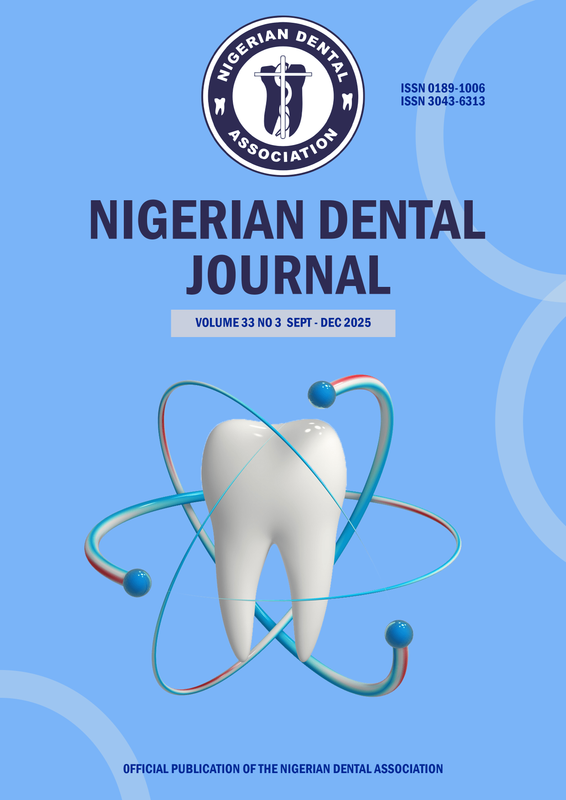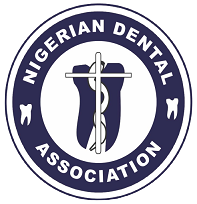UNMET PROSTHODONTIC NEEDS AND ORAL HEALTH RELATED QUALITY OF LIFE AMONG TRADERS IN AN URBAN KANO MARKET: A PILOT SURVEY
DOI:
https://doi.org/10.61172/ndj.v32i2.288Keywords:
Prosthetic needs, Prosthetic Status, Quality of Life, Urban tradersAbstract
ABSTRACT:
Objectives:
Prosthodontic needs may affect oral health quality of life among subsets of an urban population like traders in urban markets. This study therefore aimed to evaluate the impact of unmet prosthetic needs on Oral Health Related Quality of Life (OHRQoL) among traders in urban markets within Kano metropolis.
Materials and Methods:
Institutional Ethical approval was obtained. Study location was selected after a stratified sampling of available markets. A study proforma retrieving information on sociodemographic, prosthetic status and needs; and, the Oral Health Impact Profile-14 (OHIP-14) was administered on consenting participants.
Retrieved data were summarized as frequencies, percentages and means. Prosthetic needs were quantified and assessed to derive patterns and odds ratios across participants sociodemographic characteristics. Rank Correlation and subgroup analyses were to assess the relationship between prosthetic need and OHIP-14 scores and how this is influenced by gender and age.
Results:
A total of 360 individuals participated in the study. There were 274 (76%) males and 86 (24%) females. Their ages ranged from 18 to 85 years with a mean age of 35.9 ± 14.8 years. A comparable percentage of participants were either married (48%), or had never been married (44.1%). Participants who identified as Muslim (84.7%) predominated, and Hausa/Fulani (69.4%) were the predominant ethnic identity. Many (48.1%) of participants had at least a secondary school level of education.
About a fifth (79 or 21.9%) of the participants had a prosthodontic need. Unmet needs were present in 51(64.6%) of this segment of the participants. Females were more likely to have a prosthesis (OR = 2.01; 95% CI: 0.90, 4.74). Prostheses were more common among participants 50 years or older (OR=7.49; 95% CI:1.50, 37.29) and were about 3.5 times more likely to be found in individuals who had at least a secondary school education.
Mean OHIP-14 scores was 1.3±3.9 in those without prosthetic needs and 13.1±12.7 for those with needs. Prosthetic need influenced OHIP=14 scores in all tested domains (p<0.001). Prosthetic needs correlated with OHIP-14 scores (rs=0.64, p<0.001). The correlation between prosthetic needs and OHIP-14 scores was stronger in females (p<0.001) and with increasing age (p<0.001).
Conclusion:
There was a high level of unmet prosthetic need within the studied population. Prosthetic need was inversely related to Oral Health Related Quality of Life. Increasing age and female gender were directly related to prosthetic needs and prosthetic status.
Downloads
References
Aladejare SA, Ebi BO, Ubi PS. Quality of life and the fundamental issues to be addressed in west African countries. J Econ Coop Dev. 2022; 43(2): 225-51.
Osakede UA. Public health spending and health outcome in Nigeria: the role of governance. Int J Dev Issues. 2021; 20(1): 95-112.
Gureje O, Kola L, Afolabi E, Olley BO. Determinants of quality of life of elderly Nigerians: results from the Ibadan study of ageing. Afr J of Med Med Sci. 2008; 37(3): 239-47.
Igboanugo IN, Dauda RO. Education, health expenditure and the quality of life in Nigeria. Acad J Econ Stud. 2019; 5(4): 94-102.
Karimi M, Brazier J. Health, health-related quality of life, and quality of life: what is the difference? Pharmacoeconomics. 2016; 34: 645-9.
de Oliveira Almeida K, Nogueira Alves IG, de Queiroz RS, de Castro MR, Gomes VA, Santos Fontoura FC, Brites C, Neto MG. A systematic review on physical function, activities of daily living and health-related quality of life in COVID-19 survivors. Chronic Illn. 2023 Jun;19(2):279-303.
Mao Z, Ahmed S, Graham C, Kind P, Sun YN, Yu CH. Similarities and differences in health-related quality-of-life concepts between the East and the West: A qualitative analysis of the content of health-related quality-of-life measures. Value Health Reg Issues. 2021; 24: 96-106.
Sischo L, Broder H. Oral health-related quality of life: what, why, how, and future implications. J Dent Res. 2011; 90(11): 1264-70.
Amedari MI, Ejidike IC. Improving access, quality and efficiency in health care delivery in Nigeria: a perspective. PAMJ-One Health. 2021; 5: 3
Chen J, Duangthip D, Gao SS, Huang F, Anthonappa R, Oliveira BH, Turton B, Durward C, El Tantawi M, et al. Oral health policies to tackle the burden of early childhood caries: A review of 14 countries/regions. Front Oral Health. 2021: 2: 670154
Farghaly MM, Sabah AA, Keraa KM. Association between oral health-related quality of life and general health among dental patients: a cross-sectional study. J Prev Med Hyg. 2021; 62(1): E67.
Fernandes MJ, Ruta DA, Ogden GR, Pitts NB, Ogston SA. Assessing oral health‐related quality of life in general dental practice in Scotland: validation of the OHIP‐14. Community Dent Oral Epidemiol. 2006 Feb;34(1):53-62.
Silveira MF, Pinho LD, Brito MF. Validity and reliability of the oral health impact profile instrument (OHIP-14) in adolescents. Paidéia.; 29: e2921.
Omara M, Salzberger T, Boecker M, Bekes K, Steiner G, Nell-Duxneuner V, Ritschl V, Mosor E, Kloppenburg M, Sautner J, Steinecker-Frohnwieser B. Improving the measurement of oral health-related quality of life: Rasch model of the oral health impact profile-14. J Dent. 2021; 114:103819.
Choong EK, Shu X, Leung KC, Lo EC. Oral health-related quality of life (OHRQoL) after rehabilitation with removable partial dentures (RPDs): A systematic review and meta-analysis. J Dent. 2022: 104351.
Singh A, Shrestha A, Bhagat TK, Baral DD. Assessment of oral health status and treatment needs among people of Foklyan area, Dharan, Nepal. BMC Oral Health. 2020; 20(1): 320.
Uguru N, Onwujekwe O, Uguru C, Ogu U, Okwuosa C, Okeke C. Oral health-seeking behavior among different population groups in Enugu Nigeria. PLoS One. 2021; 16(2): e0246164.
Okeke MN. The informal sector as a catalyst for the economic development of Nigeria: emerging issues. J Manage Sci. 2021; 57:255.
Isa, U.F., Liman, M., Mohammed, M.U., Mathew, O.S., & Yayo, Y.R. Spatial Analysis of Fire Service Station in Kano Metropolis, Nigeria. IOSR J Humanit Soc Sci. 2016; 21: 42-52.
Micah DJ, Alabi JT. Small Enterprises: Benefits and Prospect among Traders in Sabon Gari Market, Kano State, Nigeria. Int J Soc Sci. 2017; 11(2): 102-9.
Personal communication with Market Secretary
Garg P, Klineberg I. Benefits of Contemporary Rehabilitation of Edentulism: A Statement. Int J Prosthodont. 2022; 35(5): 575-580
Olabisi AA, Ifeanyi CE. Teeth retention, prosthetic status and need among a group of elderly in Nigeria. Dent. 2012; 2(1): 1000117.
Singh R, Mangat NS, Singh R, Mangat NS. Stratified sampling. Elements of Survey Sampling. Springer Link (USA) 1996:102-44.
Li F, Tian Z, Bobb J, Papadogeorgou G, Li F. Clarifying selection bias in cluster randomized trials. Clin Trials. 2022; 19(1): 33-41.
Okojie CE. Female migrants in the urban labour market: Benin City, Nigeria. Can J Afr Stud. 1984: 547-62.
Abba MA, Maina JJ, Sagada ML. Socio cultural aspects of space use in markets in Kano State, Nigeria: a case study of Kurmi and Kantin Kwari markets. In proceedings of the 2018 National Conference 2018 Feb 21 (p. 357).
Nwaka JC. Host-Settler Relations, Conflict Dynamics, and Threatened Identity in Kano. Stud Peace Confl. 2012; 2010:70-83.
Kuo HC, Yang YH, Lai SK, Yap SF, Ho PS. The association between health‐related quality of life and prosthetic status and prosthetic needs in Taiwanese adults. J Oral Rehabil. 2009; 36(3): 217-25.
Nadgere J, Gala-Doshi A, Kishore S. An evaluation of prosthetic status and prosthetic need amongst people living in and around Panvel, Navi-Mumbai-A survey. Int J Prosthet Dent. 2010; 1(1): 6-10.
Chisini LA, Sarmento HR, Collares K, Horta BL, Demarco FF, Correa MB. Determinants of dental prosthetic treatment need: A birth cohort study. Community Dent Oral Epidemiol. 2021 Oct;49(5):394-400.
Omo JO, Enabulele JE. Self-reported prevalence of missing teeth and unmet prosthetic treatment needs among a population of Nigerian undergraduate students. Kanem J Med Sci. 2020: 1-9.
Akinboboye, B.O., Azodo, C.C., & Soroye, M. (2014). Partial edentulism and unmet prosthetic needs amongst young adult Nigeria. Odontostomatol Trop. 2014; 37 (145): 47- 52.
Choudhury GK, Vadavadagi SV, Kumari KH, Mandokar RB, Prathima K. Prosthetic status and prosthetic needs of patients attending the Prosthodontic Department of a Dental Teaching Institution, India. J Int Oral Health. 2016; 8(3): 338-343
Chisini LA, Sarmento HR, Collares K, Horta BL, Demarco FF, Correa MB. Determinants of dental prosthetic treatment need: A birth cohort study. Community Dent Oral Epidemiol. 2021;49(5):394-400.
Imam AY. Impact of Tooth Loss Position on Oral Health-Related Quality of Life in Adults Treated in the Community. J Pharm Bioallied Sci. 202;13(Suppl 2); S969-S974.
Anbarserri NM, Ismail KM, Anbarserri H, Alanazi D, AlSaffan AD, Baseer MA, Shaheen R. Impact of severity of tooth loss on oral-health-related quality of life among dental patients. J Family Med Prim Care. 2020; 9(1): 187-191
Kimmie-Dhansay F, Pontes CC, Chikte UM, Chinhenzva A, Erasmus RT, Kengne AP, Matsha TE. Impacts of tooth loss on OHRQoL in an adult population in cape town, South Africa. Int J Environ Res Public Health. 2021 ;18(9):4989.
Downloads
Published
Issue
Section
License
Copyright (c) 2024 Olufeyisayo Ikusika, Albert Zirra, Afamdi Iwuchukwu, Raymond Ngwu, Farida Bappah

This work is licensed under a Creative Commons Attribution 4.0 International License.
Open Access Statement
- We became fully Open Access since January 2023.
- Our new and archived materials are available free of charge on open basis and under a Creative Commons license as stated below.
Copyright statement
Copyright © 1999 The authors. This work, Nigerian Dental Journal by Nigerian Dental Association is licensed under Creative Commons Attribution 4.0 International License.


